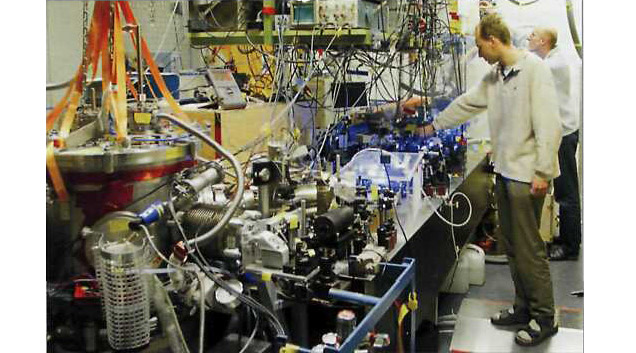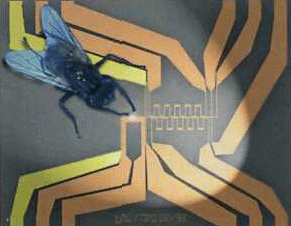Laser spectroscopy with extreme precision, laser frequency comb synthesizer
Prof. T. Hänsch, Experimental Physics, MPQ
For more detailed information, see www.mpq.mpg.de/~haensch/
Main research areas: Ultra-high-resolution laser spectroscopy; quantum physics of ultra-cold atoms.
The Laser Spectroscopy Division are developing and applying the very latest laser techniques to explore fundamental questions of physics in new ways. Ultra-high-resolution spectroscopy of the hydrogen atom is one example. As the simplest atom, hydrogen allows unique comparisons to be made between experimental findings and quantum-mechanical theory. The optical frequency of a hydrogen resonance (1S-2S transition), for instance, can now be accurately measured to 13 decimal places. The experiments at Garching have already yielded the most accurately measured natural constant (Rydberg constant), the most precise test of quantum electrodynamics and the most exact values for the charge radii of the proton and deuteron. Future experiments could reveal possible slow changes in natural constants.
 Pic. 1. Ultra-high-resolution laser spectroscopy of the hydrogen atom. Foreground: vacuum chamber of the atomic beam apparatus; background: high-stability blue dye laser being adjusted.
Pic. 1. Ultra-high-resolution laser spectroscopy of the hydrogen atom. Foreground: vacuum chamber of the atomic beam apparatus; background: high-stability blue dye laser being adjusted.
The division is a partner in an international collaboration (ATRAP), which in autumn 2002 succeeded in producing slow anti-hydrogen atoms at the European research centre, CERN. The objective is to subject anti-hydrogen to high-precision laser spectroscopy in order to detect any differences between matter and anti-matter.In this context, scientists at Garching achieved an epoch-making breakthrough in precision spectroscopy. A frequency-comb synthesizer now allows for the first time precise recording of the very fast oscillations of light. Menlo Systems GmbH, a separate company established by MPQ, has been supplying commercial frequency-comb synthesizers to laboratories throughout the world since early 2002 (www.menlosystems.com).
A second main area of research is quantum physics of ul-tra-cold atoms. Here, a central role is played by laser cooling of atomic gases, already invented in 1974 by T. Hänsch and A. Schawlow. Laser cooling opens up new avenues into the remarkable and fascinating world of quantum optics and provides an important tool for Bose-Einstein condensation of ultra-cold atoms (Nobel Prize in Physics 2001).
 Pic. 2. Micro-produced „atom chip” as compared in size
Pic. 2. Micro-produced „atom chip” as compared in size
with a housefly. Such a chip can accommodate a quantum
laboratory for manipulating ultra-cold atoms.
In a Bose-Einstein condensate, at very low temperatures of just a few millionths of a degree above absolute zero, atoms lose their particle properties and behave as a single coherent wave. From a Bose-Einstein condensate in a magnetic cage it is thus possible to decouple a laser-like beam of coherent matter waves. Such an atomic laser allows fascinating experiments in coherent atomic optics.A Bose-Einstein condensate can also be trapped in a periodic potential landscape produced by optical dipole forces in the interference pattern of superposed laser beams. In such a light-bound atomic lattice one can observe quantum effects in solid-state physics at the atomic densities of a good vacuum.
It was thus possible for the first time to demonstrate a reversible quantum phase transition from a wave-like, superfluid state of matter to a crystalline particle state of a Mott isolator. Furthermore, Bose-Einstein condensates can meanwhile be produced and manipulated in tiny magnetic atom traps on a micro-produced „atom chip”. By combining traps, waveguides and other atom-optical elements it is thus possible to accommodate a quantum laboratory on a microchip. Prospective applications range from atom interferometry to quantum Information processing.
Contribution to IMPRS curriculum:
"Ultracold atoms and new quantum matter"
Lecturer: Theodor Hänsch (3+1 hours/week)
Content:
Light and atoms; laser cooling and applications; magnetic traps for neutral atoms, optical dipole traps, evaporative cooling; Bose- Einstein condensation in atomic gases; quantum statistics; cold collisions; Gross-Pitaevskii equation; loss processes in Bose- Einstein condensates; selected experiments with Bose-Einstein condensates; coherent matter waves; atom lasers; superfluidity; vortices; cold atoms in periodic lattice potentials; strongly correlated quantum gases; superfluid to Mott insulator transition; ultracold fermions; molecular Bose-Einstein condensates; BEC to BCS crossover regime; late breaking news.
"Nonlinear Optics"
Lecturer: Theodor Hänsch (3+1 hours/week)
Content:
Nonlinear optical phenomena; nonlinear optical susceptibility; sum and difference frequency generation; frequency doubling; OPO; intensity-dependent refractive index; self-focusing; optical phase conjugation; optical bistability; solitons; spontaneous light scattering and acoustooptics; stimulated Brillouin and stimulated Rayleigh scattering; stimulated Raman scattering; the electrooptic and photorefractive effects: multiphoton processes; ultrafast and intense-field nonlinear optics; high harmonic generation; nonlinear optics of plasmas and relativistic nonlinear optics, new developments.
